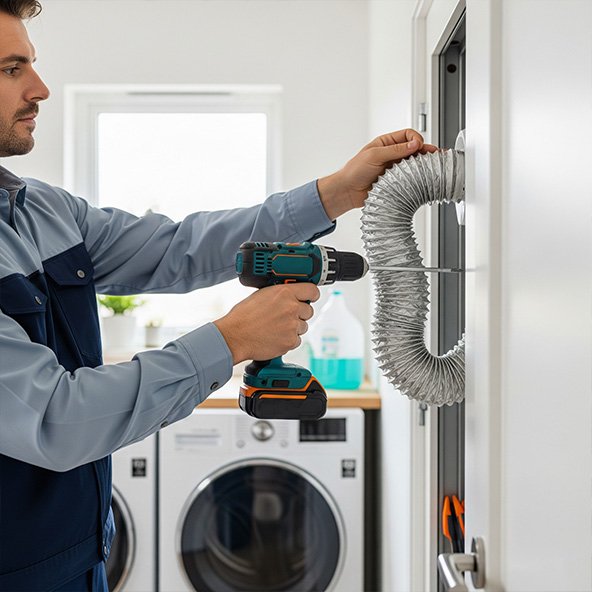Setting up a laundry room that’s both efficient and safe begins with something many homeowners overlook laundry dryer vent installation. It might seem like just another step, but it plays a huge role in protecting your home from trapped lint, air quality issues, and even fire hazards. Whether you’re installing a new vented dryer, replacing existing ducting, or dealing with more complicated venting paths, this guide walks you through every step in a way that’s clear and easy to follow.
Why Proper Dryer Venting Matters
Every time your dryer runs, it pushes out hot, moist air—sometimes carrying tiny fibers of lint. That exhaust needs somewhere to go, and that’s where your dryer vent system comes in. A well-installed dryer vent effectively pushes out this air, reducing build up and ensuring your clothes dry faster.
Improper or unnecessarily complicated venting hookups can clog with as much lint as your trap misses. That leads to poor performance, higher energy bills, and in some cases, breathing problems due to mold or humidity buildup inside your laundry room. Plus, a backed-up dryer exhaust can overheat, creating a serious fire risk.
Understanding the Dryer Vent System
A standard dryer vent system includes several parts: the dryer exhaust outlet, vent hose, vent clamps, vent elbows, dryer duct, vent outlet grill, and the exhaust hood outside. Each piece plays a vital role in guiding airflow smoothly from your dryer inside to the exterior wall.
Your job is to effectively vent dryer exhaust through a secure, sealed pathway. The exact path depends on your setup, but the principles are always the same: keep the vent short, avoid unnecessary turns, and secure it tightly at every junction.
Choosing the Right Materials: Flex vs. Rigid
There are two main options for connective ducting: flexible metal venting and rigid metal ducts. For more complicated venting paths, flexible ducting is easier to work with. It bends around corners and adapts to tight spaces. Just keep in mind that it can collect more lint over time if not properly supported.
Rigid ducts are solid material, smooth inside, and easier to keep clean. They’re generally recommended if you can install them in a mostly straight line. Always avoid plastic or foil vents that aren’t labeled for dryer use—these can pose serious fire hazards and don’t meet most dryer product specifications.
Planning the Installation
Before you install a dryer vent, start with a little prep:
Measure the required vent length using a measuring tape.
Identify your wall outlet location—this is where your vent outlet grill or hood duct will go.
Check your owner’s manual for any brand-specific recommendations.
Clear out any remaining lint using a vacuum hose.
Whether you’re working with a new ductwork setup or upgrading an old one, you want very little slack in your dryer’s vent duct. The smoother and shorter the vent path, the better your dryer performs.
How to Install a Dryer Vent (Step-by-Step)
Here’s a simple process that most homeowners can handle with the right tools and a little patience.
Step 1: Prep and Cut
Use tin snips tools to cut your ducting to size. Always wear protective work gloves—those metal edges can be sharp. If you’re using flexible metal venting, keep it as straight as possible. Measure carefully and cut your dryer duct to the exact length between the dryer exhaust outlet and exterior wall.
Step 2: Attach the Duct to the Dryer
Slide the vent hose onto the dryer exhaust outlet, then secure it with a vent clamp loosely. Don’t tighten it down just yet—you may need to make small adjustments once you connect the other end. Avoid using regular duct tape here, as it can dry out and fail. Instead, use foil tape, which is heat-resistant and made specifically for this kind of work.
Step 3: Route the Ductwork
Guide the ducting to your wall vent. If you’re working with vent elbows due to complicated venting paths, make sure they’re not too sharp—gentle turns reduce resistance and collect less lint. Fit everything together for a snug fit with solid material wrapped around all connections.
Step 4: Install the Exterior Vent
Now it’s time to drill a hole through your exterior wall for the hood duct. Be sure to angle it slightly downward to prevent rainwater from entering. Attach the vent cover securely and seal any gaps with tape meant for exterior use or caulk.
Once the vent outlet grill is in place, connect the opposite end of the ducting using a second vent clamp. Make sure everything lines up tightly and securely.
Step 5: Final Check
With everything fully installed, turn on your dryer and feel for strong airflow outside. If you notice weak air or feel hot air leaking inside, recheck all your joints. A small air leak might not seem like much, but it can cause a lot of problems over time.
Extra Tips for a Safer, Cleaner Laundry Room
Clean your dryer’s vent duct at least once a year with a vacuum hose or brush kit.
Check behind the dryer occasionally to ensure the vent hose isn’t crushed or disconnected.
Replace any duct tape that’s peeling or brittle with foil tape.
Avoid venting into attics or crawl spaces—always vent outdoors.
Watch for signs like longer drying times or a hot laundry room. These may indicate a clog.
When to Replace Your Vent
If your dryer vent is cracked, bent, or covered in lint, it’s time to replace it. Whether you’re setting up a new vented dryer or reworking old lines, the process is similar.
Disconnect the old vent, clean out the dryer exhaust, and follow the steps above to install the new venting hookups. It’s usually easier than you think—and far more affordable than dealing with a clogged or hazardous system.
Cost of Installation
Doing it yourself? Expect to spend $30 to $80 on materials—vent hose, vent clamps, foil tape, and maybe a new exhaust hood. If you’re hiring a pro, dryer vent installation typically ranges between $150 and $275 depending on your wall type, vent path, and accessibility.
Properly venting your dryer is one of those home improvements that pays off every single day. You’ll get cleaner clothes, shorter dry times, and most importantly, peace of mind knowing your dryer exhaust is handled safely and efficiently.
We hope you found this article helpful in making your dryer vent installation a breeze. It’s a simple process, but when done right, it protects your home from costly repairs and helps your dryer work at its best.
If you’re unsure about drilling through an exterior wall or dealing with more complicated venting paths, don’t hesitate to contact a local professional. A few hours of careful work today can prevent years of future headaches.


